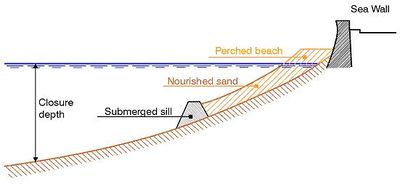Difference between revisions of "Perched beaches"
Dronkers J (talk | contribs) |
Dronkers J (talk | contribs) |
||
| Line 1: | Line 1: | ||
| + | {{Definition|title=Perched beach | ||
| + | |definition=Perched beaches are natural or nourished beaches at locations with a steep shoreface. They are supported at their lower part by a submerged structure. | ||
| + | }} | ||
Revision as of 19:23, 6 October 2021
Definition of Perched beach:
Perched beaches are natural or nourished beaches at locations with a steep shoreface. They are supported at their lower part by a submerged structure.
This is the common definition for Perched beach, other definitions can be discussed in the article
|
Method
A perched beach provides a wider beach at locations where the natural beach has become too narrow and low due to the erosion of the coastal profile at a location, where the coastline is fixed, see Fig. 1. It will require large amounts of fill sand if the sand available for beach fill is of the same quality as or slightly finer than the natural sand because the it should, in principle, reach the closure depth in order to be stable. To avoid this, the submerged sill is introduced to support the lower part of the profile.
Functional characteristics
The perched beach concept is, in principle, very simple; the submerged sill replaces the outer part of the active equilibrium coastal profile. However, under extreme wave conditions and storm surge, the perched beach profile may adjust to the extreme conditions by moving sand from the upper part of the profile to deeper water, i.e. over the sill. This will be a reversible process for a normal beach profile, but for a perched beach, the process will lead to permanent loss of sand over the sill.
High waves combined with low tide would lead to wave-breaking over the sill and hence mass transport of water over the sill. An undertow would compensate for this landward transport of water but would also lead to a loss of sand from the perched beach profile.
If the sill is made very high in order to minimise the sand loss, extreme conditions may lead to undesirable wave-breaking and a mass transport of water over the sill. This will result in current circulation and undertow currents, both of which are dangerous and difficult to control. In calmer conditions, the high sill may result in stagnant water and poor water quality.
The conclusion is that a perched beach should not be designed with an extra high sill to minimise sand loss. A further consequence is that a perched beach requires a lot of maintenance.
Applicability
The perched beach concept is applicable on exposed or moderately exposed shorelines with perpendicular or near-perpendicular wave incidence at locations with a steep and eroded coastal profile. It shall be noted that it should not applied on coasts with oblique wave attack. In general, a perched beach is not recommended as a sustainable shoreline management solution due to the risk of dangerous currents and loss of sand.
References
Further reading
Mangor, K., Drønen, N. K., Kaergaard, K.H. and Kristensen, N.E. 2017. Shoreline management guidelines. DHI https://www.dhigroup.com/marine-water/ebook-shoreline-management-guidelines
Please note that others may also have edited the contents of this article.
|
